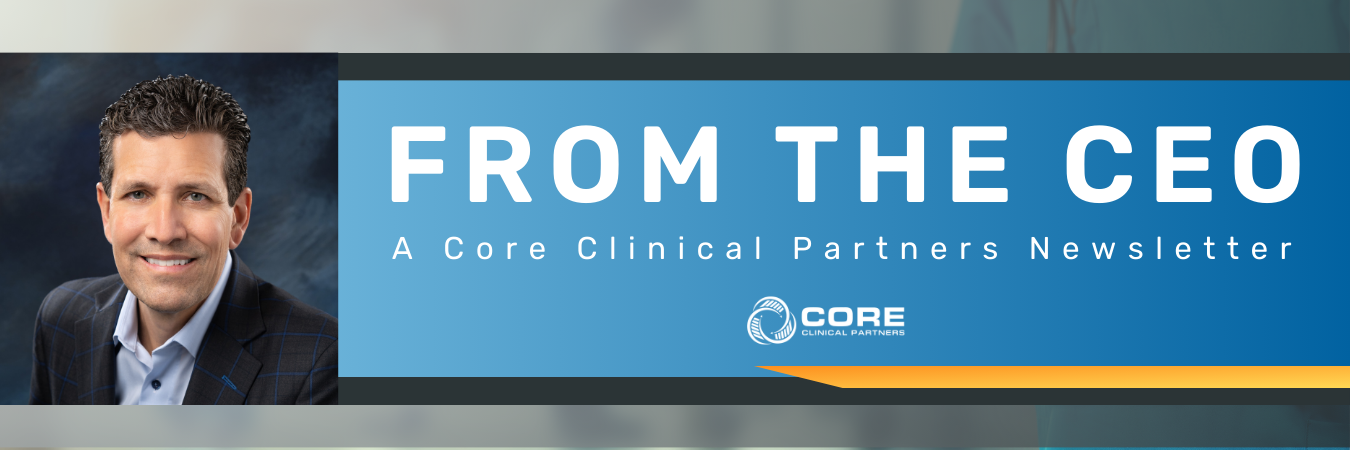Agile Frameworks: Core’s Solution to Healthcare’s Challenges | ISSUE #19
Greetings from Atlanta and hope your 2024 is off to a great start! Certainly, ours has been off to a busy one as evidenced by the new business we started here, here, and here!
While all this new growth is fantastic and has demanded significant time and energy, our primary focus this year has been on continuing to develop the infrastructure necessary to support all our current partners as well or better than ever before, while also integrating new partners effectively.
As I write this, one of our most significant infrastructure changes is migrating to Salesforce. We are far from being the first company to do this and certainly won’t be the last. I’m no expert on CRMs, so I won’t delve into the pros and cons or the timing of such a transition – though that timing in a company’s growth might be part of an interesting article on how to scale a company someday.
Agile Framework in Healthcare
What I wanted to discuss instead is how the Agile framework we’re employing for development and implementation represents exactly what we need to do more of in healthcare. This isn’t breaking news; Agile in healthcare was recently covered by our corporate partner, ACHE, in Frontiers in Healthcare and is starting to gain traction in some healthcare circles.
It’s known that healthcare has been slow to adopt technology, so it makes sense that we have also been slow to adopt the methodologies of tech companies. The notion of releasing an MVP, or ‘Minimally Viable Product’ to iterate and improve upon over time is not particularly appealing in healthcare, where patient lives are at stake. This understandable fear of failure has led to a fear of change, contributing to some stagnation with improvements in healthcare.
The aim of the Agile framework aligns closely with the Lean methodology, something we have embraced in healthcare. Both approaches are dedicated to continuous improvement, which we can all agree is vitally important to delivering quality healthcare. However, Agile framework breaks large objectives into manageable segments, granting smaller multi-disciplinary teams–or Scrums–the autonomy to tackle tasks within defined, time-bound Sprints.
Contrast this with healthcare, where introducing any new concept requires an executive sponsor to bring stakeholders together, often resulting in so many participants at the table that the process becomes bogged down or significantly delayed.
Addressing Healthcare Challenges
An easy example is inpatient length of stay (LOS). Among the myriad of challenges hospitals face today, LOS appears to me as the most significant and internally solvable problem of them all. While workforce concerns and Medicare reimbursement also keep hospital executives up at night, their sphere of influence to solve those problems quickly is much more limited. LOS is different; it presents a profoundly complex challenge involving numerous stakeholders and hundreds of facets, each ripe for improvement.
All hospitals are working on LOS in some way these days. However, the approach I’ve seen more often than not is a top down, executive-driven, meeting-heavy process that looks across so many parts of the problem that none of them are solved. Many of the various components are interconnected, meaning that addressing LOS can’t be done entirely in a vacuum. But I submit that tackling the problem incrementally, employing Agile teams to focus on specific segments, is the better answer. While these teams must collaborate with other Agile groups to ensure their solutions do not inadvertently create new issues, effective leadership and clear communication can facilitate this process seamlessly.
Imagine, instead of a LOS Committee composed of 20 department directors, there were smaller, specialized teams assigned tasks such as:
- Developing a hospitalist-based Observation Unit to reduce Observation LOS to 18 hours.
- Overhauling the schedule for environmental services to ensure rooms are cleaned promptly, facilitating the quicker transfer of ER patients upstairs.
- Reforming (or establishing) effective interdisciplinary rounds.
- Assessing the communication platform for maximum efficiency and considering the adoption of EHR-based chat for faster asynchronous communication.
As a group that manages emergency physicians and hospitalists, we are in the middle of these LOS discussions with many of our partners. Addressing LOS is not a challenge we can overcome alone, nor can hospitals make significant strides without the active participation of hospitalists. It’s truly a partnership. Our involvement in the process across numerous hospitals has afforded us valuable insights into what works and what doesn’t in various settings.
My experience has shown more effective change, which has saved one of our hospital partners $100 million, occurs when groups are smaller, focused, and given clear deadlines. Although I hadn’t explicitly referred to it as Agile previously, after watching our teams implement Salesforce using this framework, I am realizing that the most successful hospital teams employ the same approach. Lean methodology absolutely has its place in healthcare, and our Clinical Operations teams use it every day, but I submit that healthcare needs to get more Agile in order to solve problems faster and keep our hospitals running most efficiently.
Boykin Robinson, MD, MBA, FACHE
Founder and Chief Executive Officer



